Vanuatu earthquake: Here’s why the island nation is prone to natural disasters

A 7.0-magnitude earthquake struck the Pacific archipelago of Vanuatu late Sunday, triggering a tsunami warning that was later withdrawn. The epicenter was in the sea just off the northern bay of Espírito Santo, the largest island, about 400 kilometers (250 miles) north of the archipelago’s capital, Port Vila. The shallow earthquake struck around 11:30 pm local time and was at a depth of 27 kilometers, the US Geological Survey (USGS) said.
Why is Vanuatu prone to natural disasters?
The island nation continues to face natural disasters, threatening its population of 280,000. After the tsunami warning was issued, most of the frightened villagers fled to higher ground.
According to the United Nations, Vanuatu sits on the “Ring of Fire,” an arc of seismic faults around the Pacific Ocean where earthquakes and volcanic eruptions are common.
An annual cyclone season, regular droughts and floods make the country one of the world’s most vulnerable to natural disasters.
On its overseas travel advice page, the UK government says the cyclone season in Vanuatu runs from November to May. Throughout this period there is a high risk of strong winds and heavy rain and associated flooding, mudslides and road closures.
It added that more than 2,000 seismic events are reported every year. Although most of these events are minor, large earthquakes and aftershocks of magnitude 5 occur on a regular basis.
Active volcanoes are located on the islands of Tanna, Ambe, Ambrim, Lobevi, Vanua Lava and Kava.
Impact of climate change
Vanuatu faces rising sea levels and powerful cyclones that could cripple its economy. The island nation has submitted a draft UN resolution seeking advice from the International Court of Justice (ICJ) on the legal obligations of countries to address climate change and its harmful effects.















